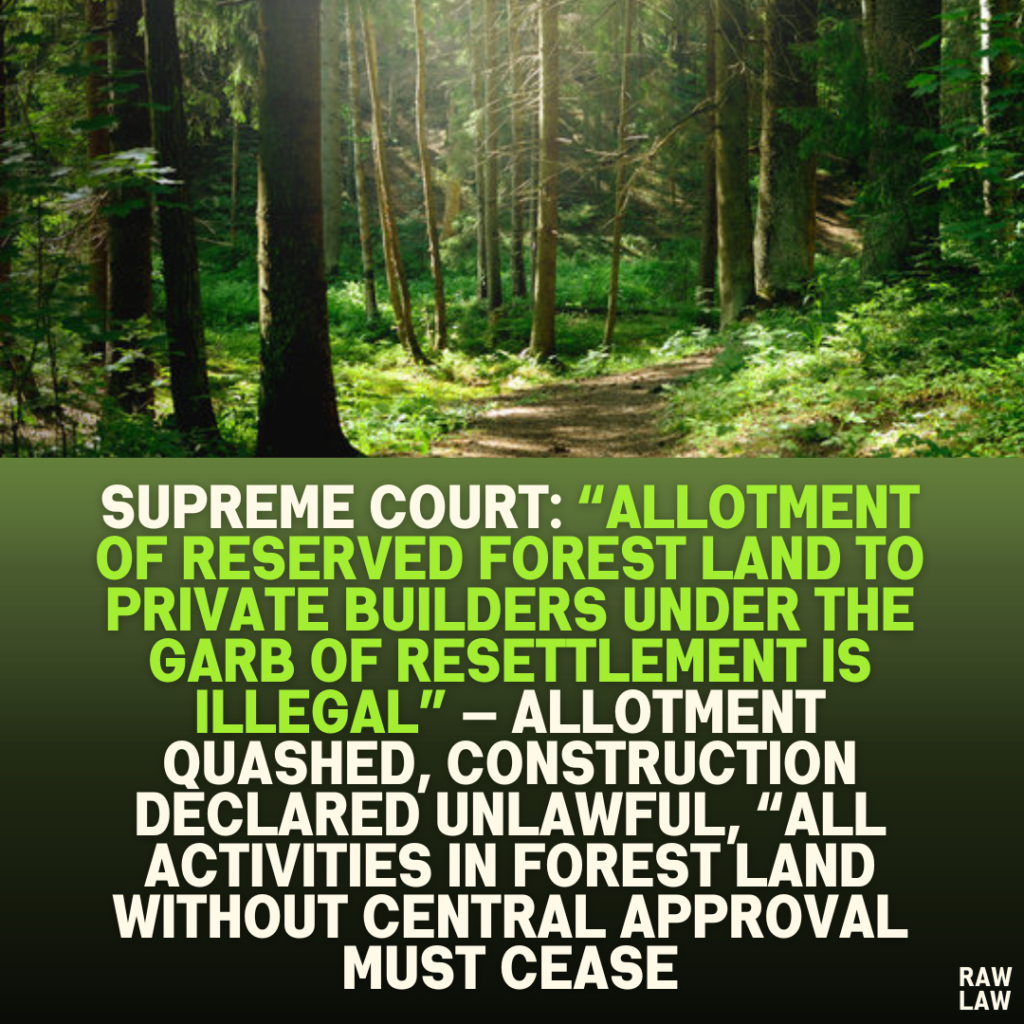Court’s Decision
The Supreme Court held that the land in question was a Reserved Forest Land since 1879, and that its allotment to private individuals, and ultimately to a builder, violated the Forest (Conservation) Act, 1980. The Court ruled that the actions of the Divisional Commissioner and Revenue Minister in facilitating the land’s transfer were illegal and in breach of public trust, and upheld the Central Empowered Committee’s (CEC) report recommending cancellation of the allotment. It observed:
“The obligation to the society must predominate over the obligation to the individuals.”
Accordingly, the Court quashed the allotment made to the so-called claimants and subsequent transfer to the builder (RRCHS), holding it as violative of law, and rejected the plea for alternate land allotment.
Facts
- In 1879, 32 acres of land in Kondhwa Budruk, Pune, were declared Reserved Forest under the Indian Forest Act, 1878.
- In 1934, 3 acres were de-reserved, leaving 29 acres as Reserved Forest.
- In 1968, the Chavan family, whose earlier land was acquired, was given temporary cultivation rights (on “Eksali” basis) for one year, with strict restrictions and no right to sell or transfer.
- No renewal occurred thereafter, and the lease expired.
- Despite this, in 1998, the entire land was allotted to the Chavan family without prior approval from the Central Government.
- Immediately after allotment, permission was granted to sell the land to a private builder (RRCHS), who began construction.
Issues
- Whether the land was still Reserved Forest Land.
- Whether the Divisional Commissioner and State Government acted lawfully in allotting the land.
- Applicability of the doctrine of desuetude.
- Whether RRCHS was a bona fide purchaser.
- Entitlement to alternate land.
- Applicability of the doctrine of public trust.
Petitioner’s Arguments
The Amicus Curiae submitted that:
- The land was legally Reserved Forest Land, and its allotment without Central Government approval was unlawful.
- The Chavan family acted as a front; deals with the builder occurred even before official allotment.
- The land was used for plantation and not agriculture.
- The transfer and construction violated binding Supreme Court orders from 1996 and the FC Act.
Respondent’s Arguments
- The builder (RRCHS) argued that the land had not been used as forest for decades and had lost its character.
- Invoked doctrine of desuetude, contending that the 1879 notification was a “dead letter.”
- Argued that RRCHS was a bona fide purchaser relying on revenue records and regional plans.
- Alternatively sought alternate land as compensation under past court directions.
Analysis of the Law
- The Court ruled that under Section 2 of the Forest (Conservation) Act, 1980, prior Central Government approval is mandatory before:
- De-reserving forest land.
- Assigning forest land to any private entity.
- Using forest land for non-forest purposes.
- The State Government’s reliance on the Banshi Ram Modi judgment was rejected, noting it was distinguishable and had been overruled by later precedents.
- The Court emphasized: “All interpretations must subserve and help implementation of the intention of the Act i.e. the protection of the forests.”
Precedent Analysis
- Ambica Quarry Works v. State of Gujarat (1986): Prior mining approvals do not allow continued deforestation.
- Nature Lovers Movement v. State of Kerala (2009): Reiterated need for Central Government approval before diverting forest land.
- Monnet Ispat v. Union of India (2012): Clarified the limited scope of desuetude.
- Earlier orders in the same Godavarman case (1996) clearly declared that all activities in forest land without Central approval must cease.
Court’s Reasoning
- The land had been notified as Reserved Forest, and no valid de-reservation occurred.
- The diversion for residential purposes was unlawful.
- The Gazette notification relied upon by RRCHS was found to be forged, as per CID’s investigation.
- RRCHS was not a bona fide purchaser, having entered into transactions even before allotment.
- Even if the revenue records showed otherwise, forest records and law prevailed.
- The public trust doctrine was violated by state authorities.
Conclusion
The Court concluded:
- The allotment orders dated 4th and 28th August 1998 are not sustainable in law.
- RRCHS is not a bona fide purchaser.
- The doctrine of desuetude is inapplicable.
- There was a breach of the Forest (Conservation) Act, and the CEC’s recommendations to restore land as forest are upheld.
Implications
- Builder’s project is illegal, and the land must be restored as forest.
- Government officials who enabled this allotment face the possibility of criminal prosecution.
- No alternate land is to be allotted, emphasizing that fraud or illegalities cannot be rewarded.
- The judgment reaffirms the Supreme Court’s continuing role in forest conservation through the Godavarman line of cases.



